Novel Psychoactive Phenethylamines: Impact on Genetic Material
Abstract
1. Introduction
2. Results
3. Discussion
4. Materials and Methods
4.1. Reagents
4.2. Synthetic Phenethylamines
4.3. Cell Culture and Treatments
4.4. Flow Cytometry
4.4.1. Cytotoxicity Analysis
4.4.2. Cytostasis Analysis
4.4.3. Apoptosis Analysis
4.4.4. Genotoxicity Analysis
4.4.5. ROS Analysis
4.5. Statistical Analysis
Author Contributions
Funding
Conflicts of Interest
Abbreviations
| 2C-B | 2,5-dimethoxy-4-bromophenethylamine |
| 2C-H | 2,5-dimethoxyphenethylamine |
| 2C-I | 2,5-Dimethoxy-4-iodophenethylamine |
| 25B-NBOMe | 4-bromo-2,5-dimethoxy-N-[(2-methoxyphenyl)methyl]-benzeneethanamine |
| DCF | 2′,7′-dichlorofluorescin |
| DCFH-DA | 2′,7′– dichlorofluorescin diacetate |
| DCFH2-DA | 2′,7′-dichlorodihydrofluorescin diacetate |
| DAT | Dopamine Transporter |
| FCS | Forward Scatter |
| MDMA | 3,4-methylenedioxy-methamphetamine |
| MMC | Mitomycin |
| MN | Micronucleus |
| NET | Norepinephrine Transporter |
| NPS | New Psychoactive Substances |
| OECD | Organization of Economic Cooperation and Development |
| PI | Propidium Iodide |
| ROS | Reactive Oxygen Species |
| RPD | Relative Population Doubling |
| SERT | Serotonin Transporter |
| VINB | Vinblastine |
References
- EMCDDA, European Monitoring Centre for Drugs and Drug Addiction. Annual Report: The State of the Drugs Problem in Europe; Publications Office of the European Union: Luxembourg, 2009; ISBN 978-92-9168-384-0. Available online: http://www.emcdda.europa.eu/system/files/publications/970/EMCDDA_AR2009_EN.pdf (accessed on 2 February 2017).
- EMCDDA. European Monitoring Centre for Drugs and Drug Addiction. European Drug Report: Key Issues Summary; Publications Office of the European Union: Luxembourg, 2020. [Google Scholar]
- UNODC. Current NPS Threats. 2020. Available online: https://www.unodc.org/unodc/en/scientists/current-nps-threats.html (accessed on 30 November 2020).
- Miliano, C.; Serpelloni, G.; Rimondo, C.; Mereu, M.; Marti, M.; De Luca, M.A. Neuropharmacology of new psychoactive substances (NPS): Focus on the rewarding and reinforcing properties of cannabimimetics and amphetamine-like stimulants. Front. Neurosci. 2016, 19, 153. [Google Scholar] [CrossRef] [PubMed]
- Luethi, D.; Liechti, M.E. Designer drugs: Mechanism of action and adverse effects. Arch. Toxicol. 2020, 94, 1085–1133. [Google Scholar] [CrossRef] [PubMed]
- EU Drug Market Report; EMCDDA: Europol, Lisbon, 2019; Available online: https://www.emcdda.europa.eu/publications/joint-publications/eu-drug-markets-report-2019_en (accessed on 11 January 2020).
- Hondebrink, L.; Zwartsen, A.; Westerink, R.H.S. Effect fingerprinting of new psychoactive substances (NPS): What can we learn from in vitro data? Pharmacol. Ther. 2018, 182, 193–224. [Google Scholar] [CrossRef] [PubMed]
- Kyzar, E.J.; Nichols, C.D.; Gainetdinov, R.R.; Nichols, D.E.; Kalueff, A.V. Psychedelic drugs in biomedicine. Trends Pharmacol. Sci. 2017, 38, 992–1005. [Google Scholar] [CrossRef] [PubMed]
- Preller, K.H.; Vollenweider, F.X. Modulation of social cognition via hallucinogens and Entactogens. Front. Psych. 2019, 10, 881. [Google Scholar] [CrossRef]
- Sessa, B. MDMA and PTSD treatment: PTSD: From novel pathophysiology to innovative therapeutics. Neurosci. Lett. 2017, 649, 176–180. [Google Scholar] [CrossRef]
- Schenk, S.; Newcombe, D. Methylenedioxymethamphetamine (MDMA) in psychiatry: Pros, cons, and suggestions. J. Clin. Psychopharmacol. 2018, 38, 632–638. [Google Scholar] [CrossRef]
- Huang, H.H.; Bai, Y.M. Persistent psychosis after ingestion of a single tablet of «2C-B». Prog. Neuropsychopharmacol. Biol. Psychiatry 2011, 35, 293–294. [Google Scholar] [CrossRef]
- Dinis-Oliveira, R.J.; Pereira, C.L.; da Silva, D.D. Pharmacokinetic and pharmacodynamic aspects of peyote and mescaline: Clinical and forensic repercussions. Curr. Mol. Pharmacol. 2019, 12, 184–194. [Google Scholar] [CrossRef]
- Hill, S.L.; Thomas, S.H. Clinical toxicology of never recreational drugs. Clin. Toxicol. 2011, 49, 705–719. [Google Scholar] [CrossRef]
- Nelson, M.E.; Bryant, S.M.; Aks, S.E. Emerging drugs of abuse. Emerg. Med. Clin. N. Am. 2014, 32, 1–28. [Google Scholar] [CrossRef] [PubMed]
- Phenethylamine. UNODC Laboratory and Scientific Section Portals. Available online: https://www.unodc.org/LSS/SubstanceGroup/Details/275dd468-75a3-4609-9e96-cc5a2f0da467 (accessed on 13 January 2020).
- Schifano, F.; Corkery, J.M.; Cuffolo, G. Smokable (ice, crystal meth) and non smokable amphetamine-type stimulants: Clinical pharmacological and epidemiological issues, with special reference to the UK. Ann. Ist. Super Sanita 2007, 43, 110–115. [Google Scholar] [PubMed]
- Halberstadt, A.L. Recent advances in the neuropsychopharmacology of serotonergic hallucinogens. Behav. Brain Res. 2015, 277, 99–120. [Google Scholar] [CrossRef] [PubMed]
- Eshleman, A.J.; Wolfrum, K.M.; Reed, J.F.; Kim, S.O.; Johnson, R.A.; Janowsky, A. Neurochemical pharmacology of psychoactive substituted N-benzylphenethylamines: High potency agonists at 5-HT2A receptors. Biochem. Pharmacol. 2018, 158, 27–34. [Google Scholar] [CrossRef]
- Pantano, F.; Graziano, S.; Pacifici, R.; Busardò, F.P.; Pichini, S. New psychoactive substances: A matter of time. Curr. Neuropharmacol. 2019, 17, 818–822. [Google Scholar] [CrossRef]
- Nichols, D.E. Hallucinogens. Pharmacol. Ther. 2004, 101, 131–181. [Google Scholar] [CrossRef]
- Katarzyna, K.; Paweł, Ś.; Kamilla, M. 25I-NBOME (2-(4-iodo-2,5-dimethoxyphenyl)-N-[(2-methoxyphenyl)methyl]ethanamine)-A HARMFUL HALLUCINOGEN REVIEW. J. Anal. Toxicol. 2020. [Google Scholar] [CrossRef]
- Zawilska, J.B.; Kacela, M.; Adamowicz, P. NBOMes-highly potent and toxic alternatives of LSD. Front. Neurosci. 2020, 14, 78. [Google Scholar] [CrossRef]
- Halberstadt, A.L. Pharmacology and toxicology of N-benzylphenethylamine (NBOMe) hallucinogens. Curr. Top. Behav. Neurosci. 2017, 32, 283–311. [Google Scholar] [CrossRef]
- Nikolaou, P.; Papoutsis, I.; Stefanidou, M.; Spiliopoulou, C.; Athanaselis, S. 2C-I-NBOMe, an N-bomb that kills with Smiles. Toxicological and legislative aspects. Drug Chem. Toxicol. 2015, 38, 113–119. [Google Scholar] [CrossRef]
- Bosak, A.; LoVecchio, F.; Levine, M. Recurrent seizures and serotonin syndrome following “2C-I” ingestion. J. Med. Toxicol. 2013, 9, 196–198. [Google Scholar] [CrossRef] [PubMed]
- Thornton, S.L.; Hoehn, S.; Gerona, R.R. Seizures, systemic inflammatory response, and rhabdomyolysis associated with laboratory-confirmed 2C-I and 25-I exposure. Pediatr. Emerg. Care. 2018, 34, e181–e183. [Google Scholar] [CrossRef] [PubMed]
- Dean, B.V.; Stellpflug, S.J.; Burnett, A.M.; Engebretsen, K.M. 2C or not 2C: Phenethylamine designer drug review. J. Med. Toxicol. 2013, 9, 172–178. [Google Scholar] [CrossRef] [PubMed]
- Andreassi, M.G.; Botto, N.; Colombo, M.G.; Biagini, A.; Clerico, A. Genetic instability and atherosclerosis: Can somatic mutations account for the development of cardiovascular diseases? Environ. Molec. Mutagen. 2000, 35, 265–269. [Google Scholar] [CrossRef]
- Hetet, G.; Elbaz, A.; Gariepy, J.; Nicaud, V.; Arveiler, D.; Morrison, C.; Kee, F.; Evans, A.; Simon, A.; Amarenco, P.; et al. Association studies between haemochromatosis gene mutations and the risk of cardiovascular diseases. Eur. J. Clin. Investig. 2001, 31, 382–388. [Google Scholar] [CrossRef] [PubMed]
- Cambien, F.; Tiret, L. Genetics of cardiovascular diseases: From single mutations to the whole genome. Circulation 2007, 116, 1714–1724. [Google Scholar] [CrossRef]
- Bagyinszky, E.; Youn, Y.C.; An, S.S.; Kim, S. The genetics of Alzheimer’s disease. Clin. Interv. Aging 2014, 9, 535–551. [Google Scholar] [CrossRef]
- Kim, D.H.; Yeo, S.H.; Park, J.M.; Choi, J.Y.; Lee, T.H.; Park, S.Y.; Ock, M.S.; Eo, J.; Kim, H.S.; Cha, H.J. Genetic markers for diagnosis and pathogenesis of Alzheimer’s disease. Gene 2014, 545, 185–193. [Google Scholar] [CrossRef]
- Van Cauwenberghe, C.; Van Broeckhoven, C.; Sleegers, K. The genetic landscape of Alzheimer disease: Clinical implications and perspectives. Genetics in medicine. Off. J. Am. Coll. Med. Genet. 2016, 18, 421–430. [Google Scholar] [CrossRef]
- Phillips, D.H.; Arlt, V.M. Genotoxicity: Damage to DNA and its consequences. EXS 2009, 99, 87–110. [Google Scholar] [CrossRef]
- Neto, F.T.; Bach, P.V.; Najari, B.B.; Li, P.S.; Goldstein, M. Genetics of male infertility. Curr. Urol. Rep. 2016, 17, 70. [Google Scholar] [CrossRef] [PubMed]
- Erickson, R.P. Somatic gene mutation and human disease other than cancer: An update. Mut. Res. 2010, 705, 96–106. [Google Scholar] [CrossRef] [PubMed]
- Johnson, Z.; Venters, J.; Guarraci, F.A.; Zewail-Foote, M. Methamphetamine induces DNA damage in specific regions of the female rat brain. Clin. Experim. Pharmacol. Phys. 2015, 42, 570–575. [Google Scholar] [CrossRef] [PubMed]
- Kamińska, K.; Noworyta-Sokołowska, K.; Górska, A.; Rzemieniec, J.; Wnuk, A.; Wojtas, A.; Kreiner, G.; Kajta, M.; Gołembiowska, K. The effects of exposure to mephedrone during adolescence on brain neurotransmission and neurotoxicity in adult rats. Neurotoxic. Res. 2018, 34, 525–537. [Google Scholar] [CrossRef] [PubMed]
- Yoshioka, H.; Shimizu, H.; Toyama, Y.; Miyakoshi, Y.; Suzuki, Y.; Takagi, R. Geonotoxicity study of illegal drug MDMA and its nitroso derivative N- MDMA by micronucleus and chromosomal aberration tests using Chinese hamsger lung fibroblast cell line. Environ. Health Prev. Med. 2007, 12, 129–137. [Google Scholar] [CrossRef] [PubMed][Green Version]
- Alvarenga, T.A.; Andersen, M.L.; Ribeiro, D.A.; Araujo, P.; Hirotsu, C.; Costa, J.L.; Battisti, M.C.; Tufik, S. Single exposure to cocaine or ecstasy induces DNA damage in brain and other organs of mice. Addict. Biol. 2010, 15, 96–99. [Google Scholar] [CrossRef]
- Alvarenga, T.A.; Ribeiro, D.A.; Araujo, P.; Hirotsu, C.; Mazaro-Costa, R.; Costa, J.L.; Battisti, M.C.; Tufik, S.; Andersen, M.L. Sleep loss and acute drug abuse can induce DNA damage in multiple organs of mice. Exp. Toxicol. 2011, 30, 1275–1281. [Google Scholar] [CrossRef]
- Fornai, F.; Lenzi, P.; Frenzilli, G.; Gesi, M.; Ferrucci, M.; Lazzeri, G.; Biagioni, F.; Nigro, M.; Falleni, A.; Giusiani, M. DNA damage and ubiquitinated neuronal inclusions in the substantia nigra and striatum of mice following MDMA (ecstasy). Psychopharmacology 2004, 173, 353–363. [Google Scholar] [CrossRef]
- Górska, A.M.; Kamińska, K.; Wawrzczak-Bargieła, A.; Costa, G.; Morelli, M.; Przewłocki, R.; Kreiner, G.; Gołembiowska, K. Neurochemical and neurotoxic effects of MDMA (ecstasy) and caffeine after chronic combined administration in mice. Neurotoxic. Res. 2018, 33, 532–548. [Google Scholar] [CrossRef]
- Test No. 487: In Vitro Mammalian Cell Micronucleus Test. In OECD Guideline for the Testing of Chemicals; OECD: Paris, France, 2016; Available online: https://www.oecd.org/chemicalsafety/-test-no-487-in-vitromammalian-cell-micronucleus-test-9789264264861-en.htm (accessed on 30 November 2020).
- Lenzi, M.; Cocchi, V.; Hrelia, P. Flow cytometry vs. optical microscopy in the evaluation of the genotoxic potential of xenobiotic compounds. Cytom. B Clin. Cytom. 2018, 94, 696–706. [Google Scholar] [CrossRef]
- Lenzi, M.; Cocchi, V.; Cavazza, L.; Bilel, S.; Hrelia, P.; Marti, M. Genotoxic properties of synthetic cannabinoids on TK6 human cells by flow cytometry. Int. J. Mol. Sci. 2020, 21, 1150. [Google Scholar] [CrossRef] [PubMed]
- Stolzenberg, S.J.; Hine, C.H. Mutagenicity of 2- and 3-carbon halogenated compounds in the Salmonella/mammalian-microsome test. Environ. Mutagen. 1980, 2, 59–66. [Google Scholar] [CrossRef] [PubMed]
- Låg, M.; Omichinski, J.G.; Dybing, E.; Nelson, S.D.; Søderlund, E.J. Mutagenic activity of halogenated propanes and propenes: Effect of bromine and chlorine positioning. Chem. Biol. Interact. 1994, 93, 73–84. [Google Scholar] [CrossRef]
- Parker, M.A.; Marona-Lewicka, D.; Lucaites, V.L.; Nelson, D.L.; Nichols, D.E. A novel (benzodifuranyl)aminoalkane with extremely potent activity at the 5-HT2A receptor. J. Med. Chem. 1998, 41, 5148–5149. [Google Scholar] [CrossRef]
- Rickli, A.; Luethi, D.; Reinisch, J.; Buchy, D.; Hoener, M.C.; Liechti, M.E. Receptor interaction profiles of novel N-2-methoxybenzyl (NBOMe) derivatives of 2,5-dimethoxy-substituted phenethylamines (2C drugs). Neuropharmacology 2015, 99, 546–553. [Google Scholar] [CrossRef]
- Hansen, M.; Phonekeo, K.; Paine, J.S.; Leth-Petersen, S.; Begtrup, M.; Bräuner-Osborne, H.; Kristensen, J.L. Synthesis and structure-activity relationships of N-benzyl phenethylamines as 5-HT2A/2C agonists. ACS Chem. Neurosci. 2014, 5, 243–249. [Google Scholar] [CrossRef]
- Luethi, D.; Liechti, M.E. Monoamine transporter and receptor interaction profiles in vitro predict reported human doses of novel psychoactive stimulants and psychedelics. Int. J. Neuropsychopharmacol. 2018, 21, 926–931. [Google Scholar] [CrossRef]
- Kolaczynska, K.E.; Luethi, D.; Trachsel, D.; Hoener, M.C.; Liechti, M.E. Receptor interaction profiles of 4-alkoxy-substituted 2,5-dimethoxyphenethylamines and related amphetamines. Front. Pharmacol. 2019, 10, 1423. [Google Scholar] [CrossRef]
- Pottie, E.; Cannaert, A.; Stove, C.P. In vitro structure-activity relationship determination of 30 psychedelic new psychoactive substances by means of β-arrestin 2 recruitment to the serotonin 2A receptor. Arch. Toxicol. 2020, 94, 3449–3460. [Google Scholar] [CrossRef]
- Halberstadt, A.L.; Geyer, M.A. Effects of the hallucinogen 2,5-dimethoxy-4-iodophenethylamine (2C-I) and superpotent N-benzyl derivatives on the head twitch response. Neuropharmacology 2014, 77, 200–207. [Google Scholar] [CrossRef]
- Elmore, J.S.; Decker, A.M.; Sulima, A.; Rice, K.C.; Partilla, J.S.; Blough, B.E.; Baumann, M.H. Comparative neuropharmacology of N-(2-methoxybenzyl)-2,5-dimethoxyphenethylamine (NBOMe) hallucinogens and their 2C counterparts in male rats. Neuropharmacology 2018, 142, 240–250. [Google Scholar] [CrossRef] [PubMed]
- Herian, M.; Wojtas, A.; Kamińska, K.; Świt, P.; Wach, A.; Gołembiowska, K. Hallucinogen-like action of the novel designer drug 25I-NBOMe and its effect on cortical neurotransmitters in rats. Neurotoxicity 2019, 36, 91–100. [Google Scholar] [CrossRef] [PubMed]
- Available online: https://psychonautwiki.org/wiki/25B-NBOMe (accessed on 30 November 2020).
- Available online: https://psychonautwiki.org/wiki/25I-NBOMe (accessed on 30 November 2020).
- Available online: https://psychonautwiki.org/wiki/2C-B (accessed on 30 November 2020).
- Available online: https://psychonautwiki.org/wiki/2C-I (accessed on 30 November 2020).
- Li, X.; Chen, S.; Guo, X.; Wu, Q.; Seo, J.E.; Guo, L.; Manjanatha, M.G.; Zhou, T.; Witt, K.L.; Mei, N. Development and application of TK6-derived cells expressing human cytochrome P450s for genotoxicity Testing. Toxicol. Sci. Offic. J. Soc. Toxicol. 2020, 175, 251–265. [Google Scholar] [CrossRef] [PubMed]
- Fowler, P.; Smith, R.; Smith, K.; Young, J.; Jeffrey, L.; Carmichael, P.; Kirkland, D.; Pfuhler, S. Reduction of misleading (“false”) positive results in mammalian cell genotoxicity assays. III: Sensitivity of human cell types to known genotoxic agents. Mutat. Res. 2014, 767, 28–36. [Google Scholar] [CrossRef] [PubMed]
- Shah, U.K.; Seager, A.L.; Fowler, P.; Doak, S.H.; Johnson, G.E.; Scott, S.J.; Scott, A.D.; Jenkins, G.J. A comparison of the genotoxicity of benzo[a]pyrene in four cell lines with differing metabolic capacity. Mutat. Res. Gen. Toxicol. Environ. Mutagen. 2016, 808, 8–19. [Google Scholar] [CrossRef] [PubMed]
- ICH. Guidance on Genotoxicity Testing and Data Interpretation for Pharmaceuticals Intended for Human Use S2(R1). The International Council for Harmonization (ICH). 2011. Available online: https://database.ich.org/sites/default/files/S2_R1_Guideline.pdf (accessed on 19 March 2020).
- Lorge, E.; Moore, M.M.; Clements, J.; O’Donovan, M.; Fellows, M.D.; Honma, M.; Kohara, A.; Galloway, S.; Armstrong, M.J.; Thybaud, V. Standardized cell sources and recommendations for good cell culture practices in genotoxicity testing. Mut. Res. 2016, 809, 1–15. [Google Scholar] [CrossRef] [PubMed]
- Hsie, A.W.; Xu, Z.D.; Yu, Y.J.; Sognier, M.A.; Hrelia, P. Molecular analysis of reactive oxygen-species-induced mammalian gene mutation. Teratog. Carcinog. Mutagenes. 1990, 10, 115–124. [Google Scholar] [CrossRef]
- Douki, T. Oxidative stress and genotoxicity in melanoma induction: Impact on repair rather than Formation of DNA damage? Photochem. Photobiol. 2020. [Google Scholar] [CrossRef]
- Valente, M.J.; Bastos, M.; Fernandes, E.; Carvalho, F.; Guedes de Pinho, P.; Carvalho, M. Neurotoxicity of β-Keto Amphetamines: Deathly Mechanisms Elicited by Methylone and MDPV in Human Dopaminergic SH-SY5Y. ACS Chem. Neurosci. 2017, 8, 850–859. [Google Scholar] [CrossRef]
- Valente, M.J.; Araújo, A.M.; Bastos, M.; Fernandes, E.; Carvalho, F.; Guedes de Pinho, P.; Carvalho, M. Editor’s highlight: Characterization of hepatotoxicity mechanisms triggered by designer cathinone drugs (β-Keto Amphetamines). Toxicol. Sci. 2016, 153, 89–102. [Google Scholar] [CrossRef]
- Zhou, X.; Luethi, D.; Sanvee, G.; Bouitbir, J.; Liechti, M.; Krähenbühl, S. Molecular Toxicological Mechanisms of Synthetic Cathinones on C2C12 Myoblasts. Int. J. Mol. Sci. 2019, 20, 1561. [Google Scholar] [CrossRef] [PubMed]
- Valente, M.J.; Amaral, C.; Correia-da-Silva, G.; Duarte, J.A.; Bastos, M.; Carvalho, F. Methylone and MDPV activate autophagy in human dopaminergic SH-SY5Y cells: A new insight into the context of β-keto amphetamines-related neurotoxicity. Arch. Toxicol. 2017, 91. [Google Scholar] [CrossRef] [PubMed]
- Luethi, D.; Liechti, M.E.; Krähenbühl, S. Mechanisms of hepatocellular toxicity associated with new psychoactive synthetic cathinones. Toxicology 2017, 387, 57–66. [Google Scholar] [CrossRef] [PubMed]
- Dias da Silva, D.; Ferreira, B.; Roque Bravo, R.; Rebelo, R.; Duarte de Almeida, T.; Valente, M.J.; Silva, J.P.; Carvalho, F.; Bastos, M.L.; Carmo, H. The new psychoactive substance 3-methylmethcathinone (3-MMC or metaphedrone) induces oxidative stress, apoptosis, and autophagy in primary rat hepatocytes at human-relevant concentrations. Arch. Toxicol. 2019, 93, 2617–2634. [Google Scholar] [CrossRef] [PubMed]
- Luethi, D.; Walter, M.; Zhou, X.; Rudin, D.; Krähenbühl, S.; Liechti, M.E. Para-Halogenation Affects Monoamine Transporter Inhibition Properties and Hepatocellular Toxicity of Amphetamines and Methcathinones. Front. Pharmacol. 2019, 10. [Google Scholar] [CrossRef] [PubMed]
- Chatterjee, N.; Walker, G.C. Mechanisms of DNA damage, repair, and mutagenesis. Environ. Molec. Mutagen. 2017, 58, 235–263. [Google Scholar] [CrossRef] [PubMed]
- De-Giorgio, F.; Bilel, S.; Tirri, M.; Arfè, R.; Trapella, C.; Camuto, C.; Foti, F.; Frisoni, P.; Neri, M.; Botrè, F. Methiopropamine and its acute behavioral effects in mice: Is there a gray zone in new psychoactive substances users? Int. J. Legal Med. 2020, 134, 1695–1711. [Google Scholar] [CrossRef]
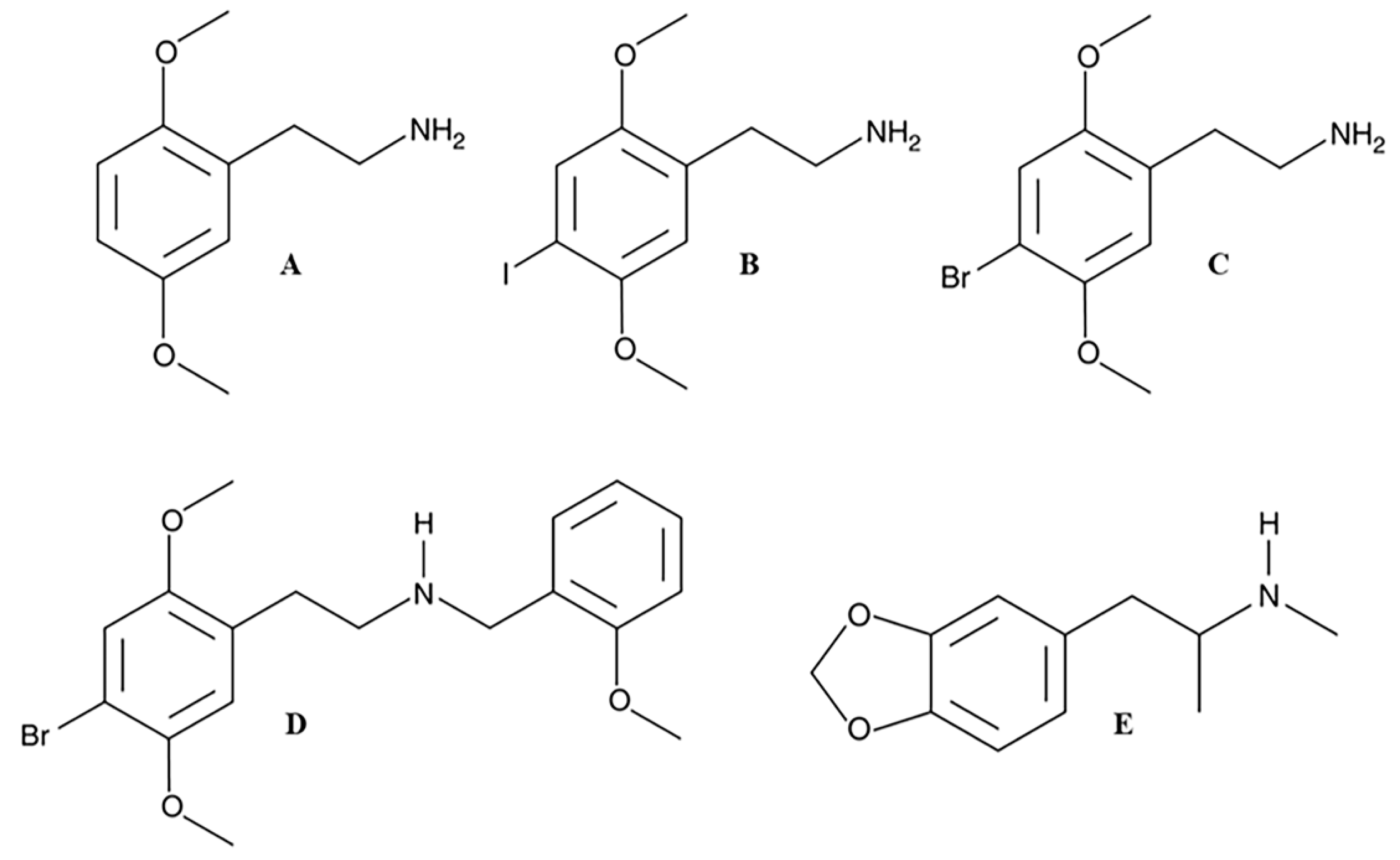



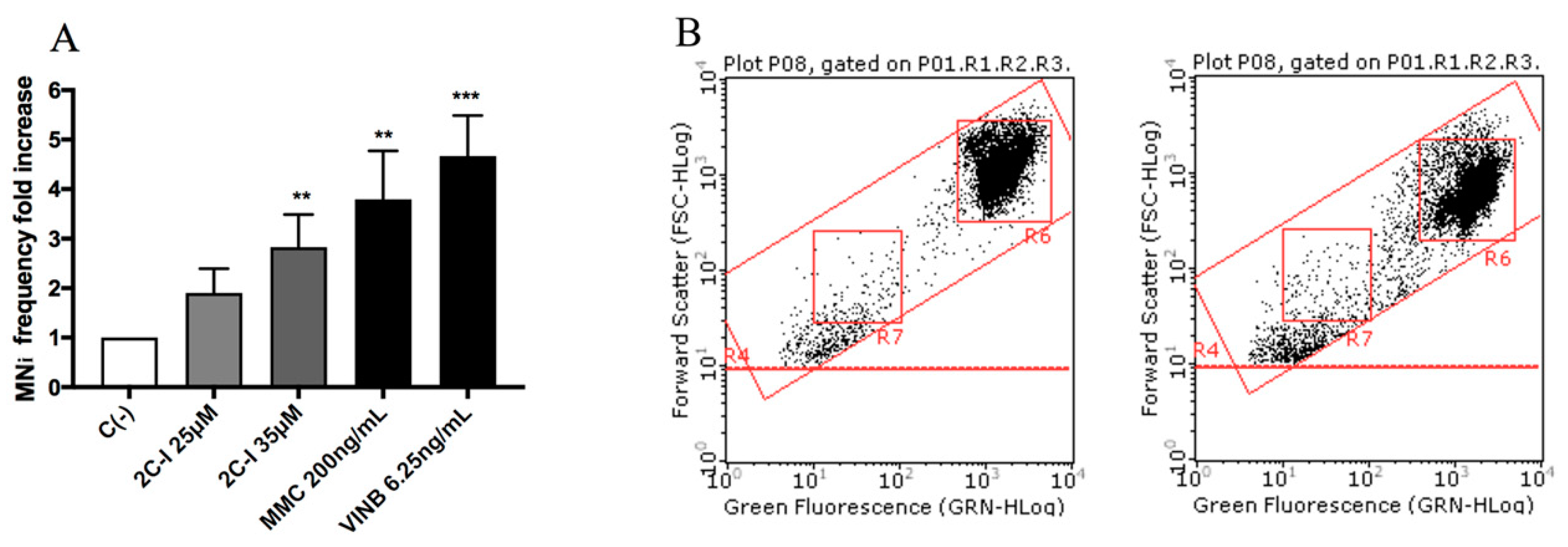
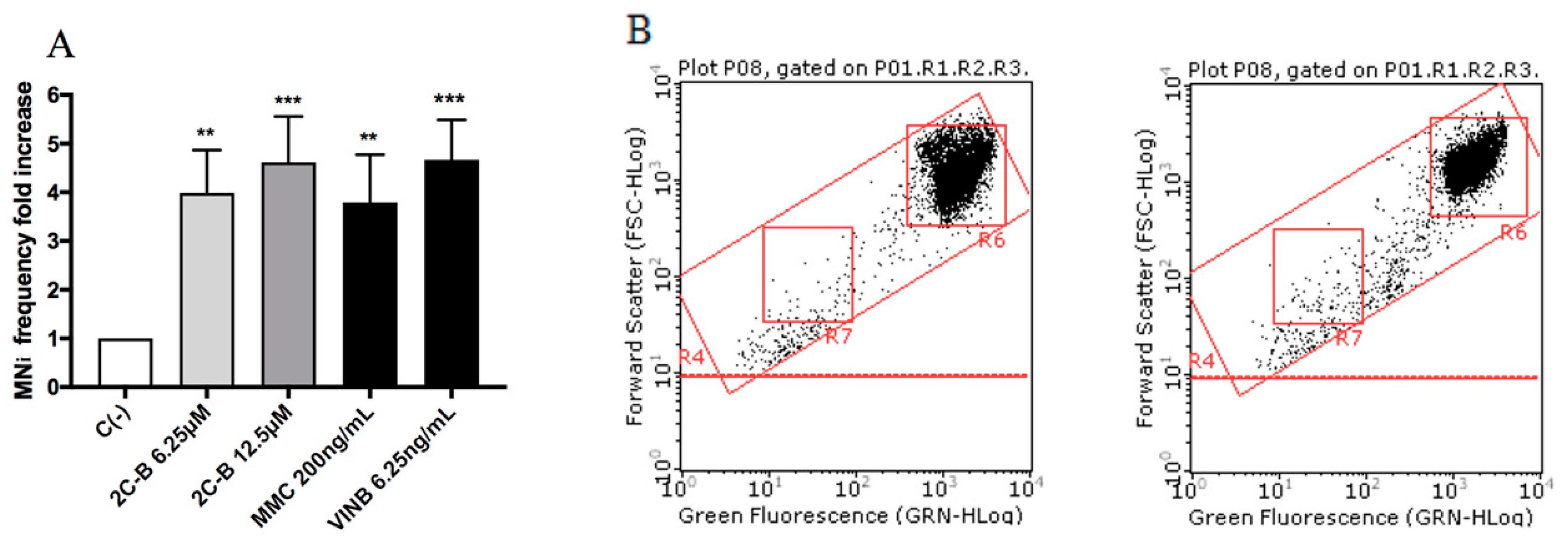
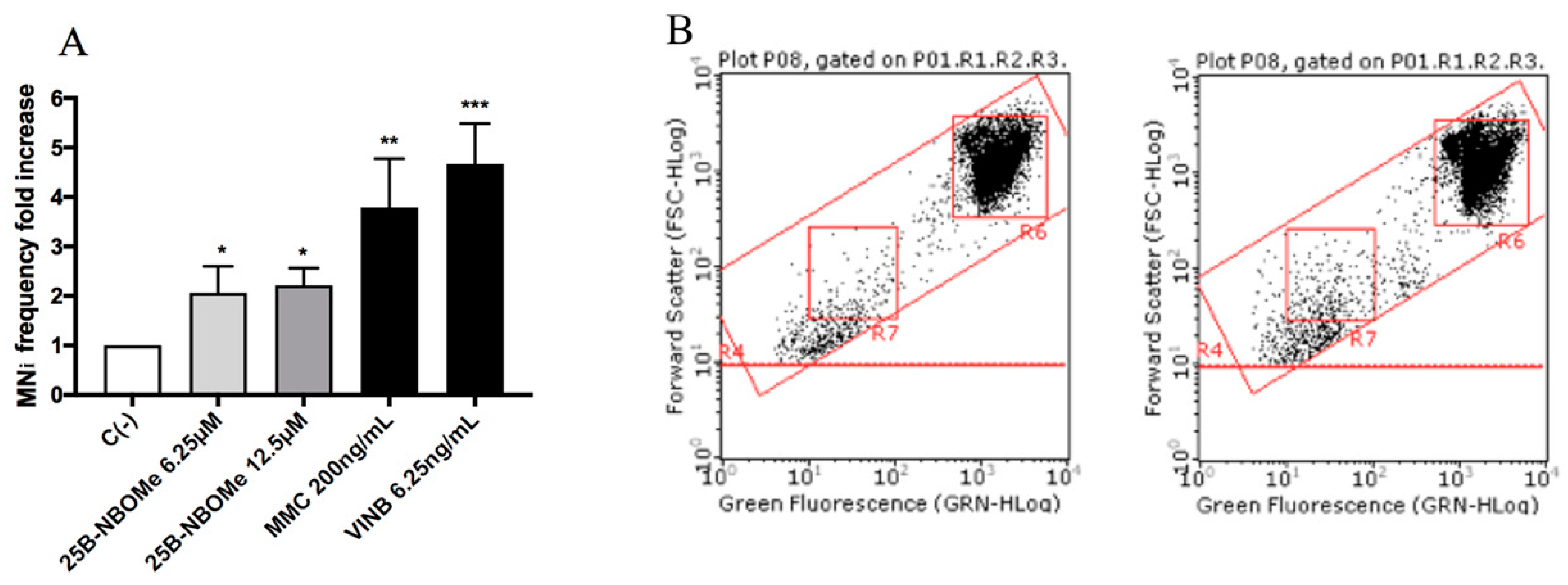
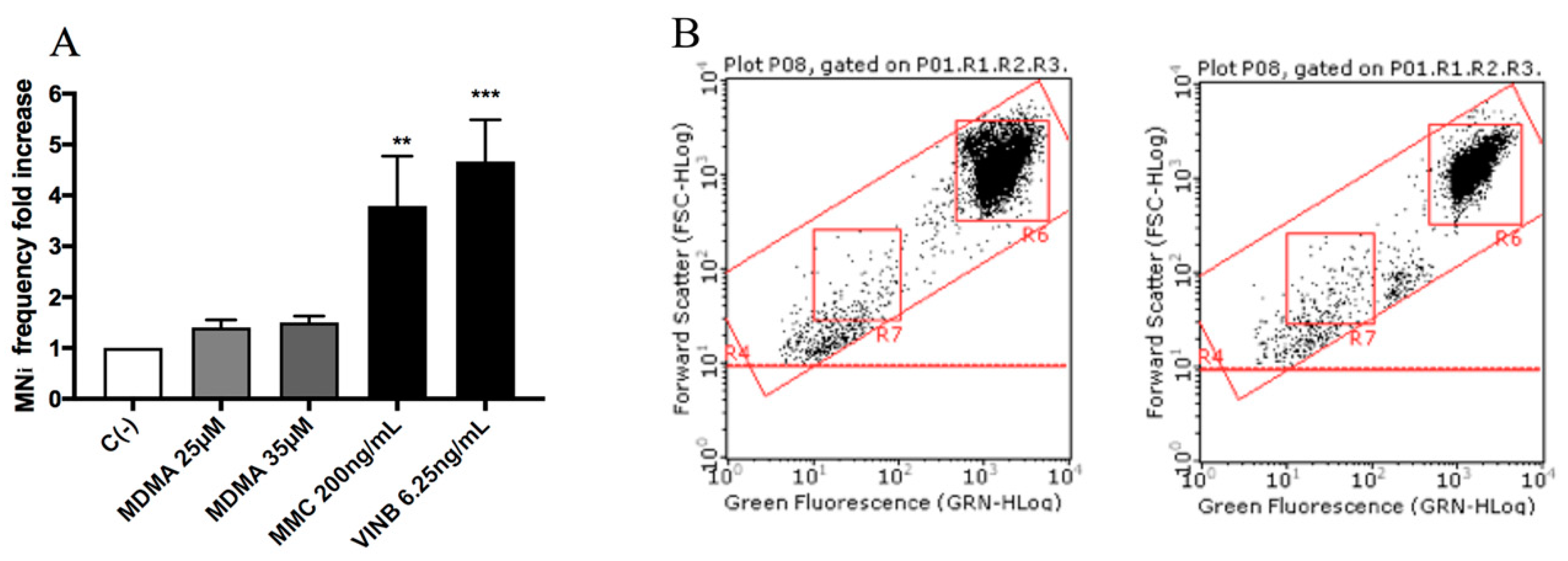
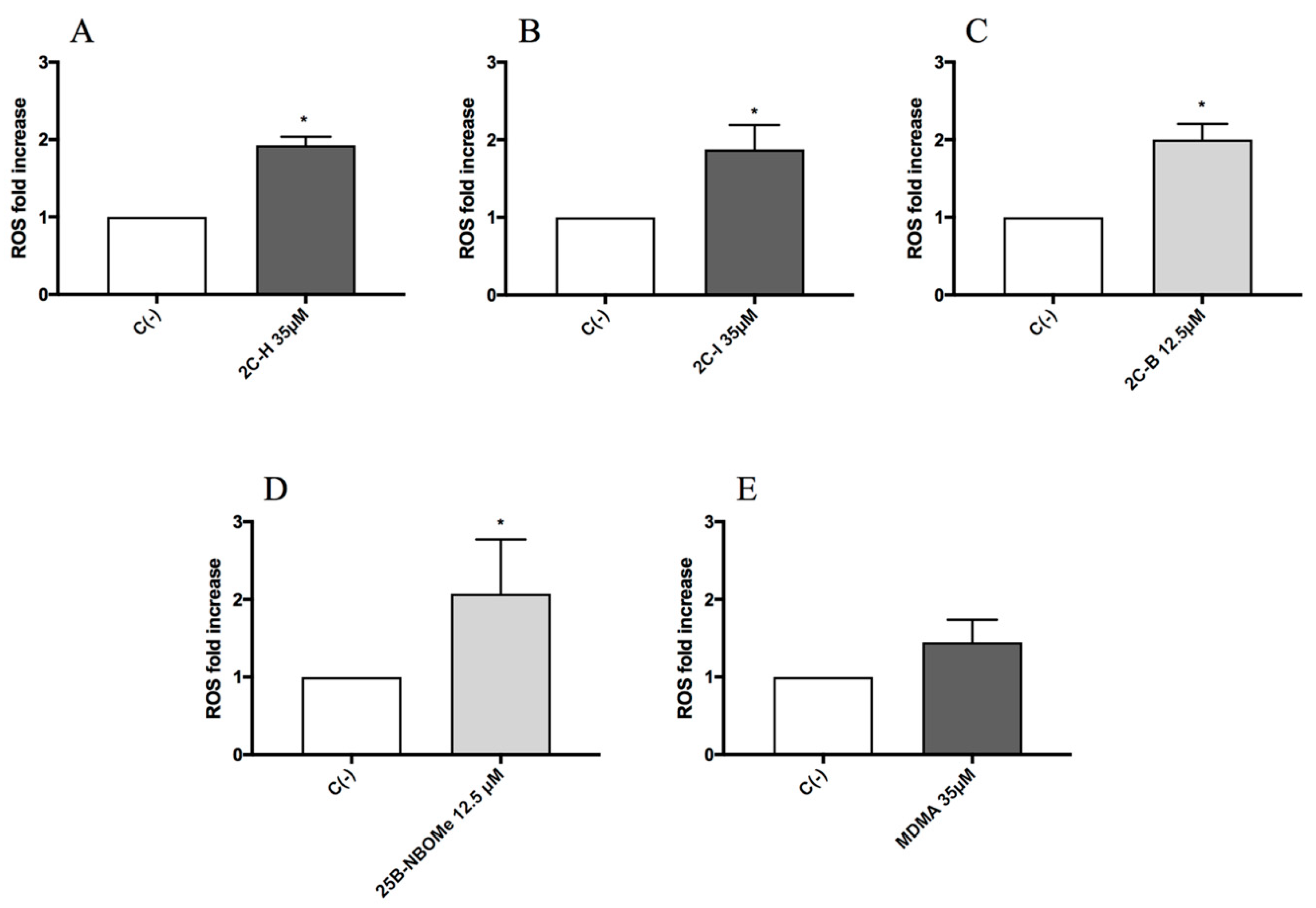
| Relative Population Doubling (RPD) | |||||
|---|---|---|---|---|---|
| 2C-H | 2C-I | 2C-B | 25B-NBOMe | MDMA | |
| C (-) | 100.00% | 100.00% | 100.00% | 100.00% | 100.00% |
| 6.25 µM | 97.5% ± 0.9 | 90.9% ± 0.7 | 95.9% ± 0.7 | 86.4% ± 1.3 | 96.0% ± 1.0 |
| 12.5 µM | 81.1% ± 1.8 | 89.6% ± 2.2 | 93.1% ± 2.1 | 81.2% ± 2.0 | 96.0% ± 0.8 |
| 25 µM | 85.0% ± 2.4 | 72.5% ± 2.0 | 69.7% ± 1.6 | 50.0% ± 0.8 | 98.7% ± 0.9 |
| 35 µM | 74.0% ± 1.8 | 63.9% ± 1.6 | 63.1% ± 1.6 | 1.0% ± 0.2 | 98.0% ± 1.5 |
| 50 µM | 34.1% ± 1.2 | 54.8% ± 0.9 | 10.0% ± 1.8 | 0.0 | 96.0% ± 1.2 |
| 75 µM | 13.0% ± 1.5 | 30.8% ± 1.0 | 0.0 | 0.0 | 91.9% ± 1.3 |
Publisher’s Note: MDPI stays neutral with regard to jurisdictional claims in published maps and institutional affiliations. |
© 2020 by the authors. Licensee MDPI, Basel, Switzerland. This article is an open access article distributed under the terms and conditions of the Creative Commons Attribution (CC BY) license (http://creativecommons.org/licenses/by/4.0/).
Share and Cite
Cocchi, V.; Gasperini, S.; Hrelia, P.; Tirri, M.; Marti, M.; Lenzi, M. Novel Psychoactive Phenethylamines: Impact on Genetic Material. Int. J. Mol. Sci. 2020, 21, 9616. https://doi.org/10.3390/ijms21249616
Cocchi V, Gasperini S, Hrelia P, Tirri M, Marti M, Lenzi M. Novel Psychoactive Phenethylamines: Impact on Genetic Material. International Journal of Molecular Sciences. 2020; 21(24):9616. https://doi.org/10.3390/ijms21249616
Chicago/Turabian StyleCocchi, Veronica, Sofia Gasperini, Patrizia Hrelia, Micaela Tirri, Matteo Marti, and Monia Lenzi. 2020. "Novel Psychoactive Phenethylamines: Impact on Genetic Material" International Journal of Molecular Sciences 21, no. 24: 9616. https://doi.org/10.3390/ijms21249616
APA StyleCocchi, V., Gasperini, S., Hrelia, P., Tirri, M., Marti, M., & Lenzi, M. (2020). Novel Psychoactive Phenethylamines: Impact on Genetic Material. International Journal of Molecular Sciences, 21(24), 9616. https://doi.org/10.3390/ijms21249616








